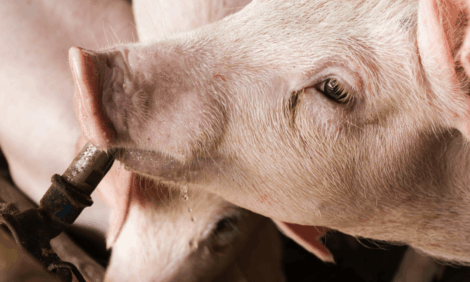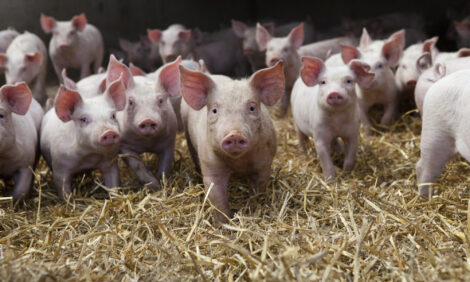



Some Clinical And Epidemiological Aspects Of An Outbreak of Classical Swine Fever in East Anglia in 2000
By J.D. Mackinnon, Stowe Veterinary Group, and published by The Pig Journal - A concise and detailed account of the Classical Swine Fever (CSF) outbreaks, occurring in East Anglia during the year 2000, is presented by the author.Extracted from: Order your copy here! View Vol. 47 here |
Summary
All aspects of the disease are covered, including epidemiology, clinical features and post-mortem findings. Effects of environment, husbandry and pig disposals are also recorded.
Introduction
The last major outbreak of Classical Swine Fever (CSF) occurred in the United Kingdom between April 10 and June 25 1986 (Williams and Matthews, 1988) although a suspected small outbreak was recorded in 1987 (Edwards, 1993). In the former, infection originated from the feeding of household scraps to pigs in three different regions of the country without proper heat treatment.
The scraps contained the same pigmeat products that had been distributed down a complex chain from importer to retailers. The primary outbreaks were contained on the first and third farms, but CSF was disseminated through Gloucester market from the second. Prior to this incident, single CSF outbreaks had been recorded in July 1971 and June 1966 (Harkness, 1985) but until March 1963, when an eradication policy was introduced, infection was common with about 1200 cases reported annually.
In this 2000 outbreak, CSF virus genotype 2.1 was recovered from all 16 cases (Sharpe et al, 2001). Identical viruses have been isolated in Austria and Switzerland, which originated from wild boar meat that had been imported illegally from China (Sandvik et al, 2000). The origin of the virus in this outbreak is a matter for speculation (Gibbens et al., 2000); but it is possible that a contaminated pork product was somehow introduced into the index herd. This could have happened in a variety of ways because it was an outdoor herd.
Since 1986, there has been a considerable increase in the number of outdoor pig units and it is estimated that around 25% of the national pig herd is now kept this way (Anon, 2000). In East Anglia, many outdoor units supply piglets at weaning to corporate rearing and finishing schemes, characteristics of which are widespread movement of pigs and the mixing of many sources together. The potential for extensive spread of CSF, and indeed other notifiable diseases of ungulates, is therefore high in the region and it is fortunate that this outbreak was limited to just 16 cases.
Two of the three cases described here occurred as a result of lateral spread in an area of relatively high pig density with outdoor production, probably from a corporate rearing unit where CSF was first identified (Infected Premises (IP) 01). This unit was supplied with weaners from one of the three cases described, which was the outdoor farm that was thought to have been the origin of the outbreak (IP02).
The beginning of the outbreak – IP02, Wilby Moor, Norfolk
The herd comprised 543 sows, gilts and boars, which, with the exception of maiden gilts, were housed outdoors. Approximately 120 sows were in farrowing paddocks, each designed to hold 6 sows and litters. The remaining sows and in-pig gilts were divided amongst two weaned sow paddocks, 8 dynamic service paddocks and 18 dry sow paddocks. Maiden gilts and underweight or infirm weaners, that would have been considered unfit for sale (“shed” pigs), were housed in conjoined buildings away from the main outdoor herd. Each week, a batch of approximately 220 newly weaned pigs would be collected from alongside the buildings by a haulier employed solely by the purchasing company. The “shed” pigs were either finished on site or they were batched into groups of about 30 and added to subsequent weekly batches of weaners when they had gained enough weight.
A routine veterinary inspection of the herd was carried out on 19 June 2000. It was an extremely hot day with temperatures recorded locally rising to 31-33ºC. The only comments made of a clinical nature were that some sows had evidence of sunburn and several showed the typical signs of heat stress, characterised by panting. The production records for the herd were reviewed in the normal course of events and it was concluded that herd performance gave no cause for concern. Mortality rates amongst the adult stock, piglets and “shed” pigs were well within normal expectations. In short, there was no evidence of clinical disease whatsoever that day; but it has subsequently been concluded from antibody decay estimations that infection was probably introduced into the herd at the beginning of the month (H.T. Morris; personal communication).

Fig. 1 – Initial events in the CSF outbreak in East Anglia in 2000
It is believed that the first sow to show clinical signs of CSF (No. 847Y) was recorded as being unwell on 20 June 2000 (Fig.1) and she subsequently died on 25 July 2000. The first batch of weaners known to be infected with CSF (212 plus 32 “shed” pigs) was sent on 27 June 2000 to a rearing unit (IP03) in Essex that had a capacity for 1900 piglets. However, it was not until 4 August 2000, 38 days later, that CSF was suspected at IP01 24 days after it had received the third batch of infected weaners from IP02 on 11 July 2000. If infection was introduced into IP02 at the beginning of June 2000, 68 days had elapsed before the diagnosis at IP01 was confirmed on 7 August 2000. This is almost three times the primary high-risk period estimated for the UK, which is defined as the period that might elapse between the introduction of CSF virus and diagnosis (Meuwissen et al., cited by Baars et al, 1998).
The true facts about the start of the outbreak are unlikely to be uncovered. An alternative to the theory that a sow gained access to a contaminated pigmeat product might be that the 32 “shed” pigs added into the first infected batch could have been the carriers. If so, how were they infected?
Lateral spread – the Iken cluster
IP01 is situated between Iken and Sudbourne in coastal Suffolk and in an area of relatively high pig density (Fig.2). The land is contiguous to the north and to the north-east with IP07, an outdoor herd that would normally comprise around 1250 breeding sows but, at the time of the outbreak, it was in the process of depopulating. Infected Premises 08, comprising 5000 growing and finishing places, lie to the north of IP07. Here, first stage growers were placed in outdoor kennels on land contiguous with IP07 before transfer into the finishing houses. To the south, IP09, which comprised 322 sows, gilts and boars, is separated from IP01 by a secondary road. The estimated distance between the buildings of IP01 and the nearest pigs of IP08 (in-pig gilts) was 500 metres. Infected premises 09 was part of a larger enterprise which had a further 300 sows housed indoors.
The total weekly progeny from both sow herds were reared together in “villages” of outdoor kennels on a separate and non-contiguous site and they were finished indoors at another. There was no evidence for the spread of CSF beyond the outdoor sows by the time the herd was slaughtered on 16 September 2000. Two other herds in the area, one indoors and the other outdoors, were slaughtered as part of the control programme. Both were sero-negative. Serological results from the positive herds mentioned thus far (H. T. Morris; personal communication) suggest that the secondary high-risk periods, defined as the time elapsed between infection and slaughter of herds infected by lateral spread, are relatively long for outdoor herds (Table 1). The emergence of clinical signs in outdoor herds is insidious, probably because of lower virulence of the CSF virus in adult pigs and a tendency for infectious diseases to spread more slowly in the open air. Careful consideration should be given to the way in which sows are moved around an outdoor unit and of the mating systems used when selecting animals for prospective diagnostic monitoring procedures.
 Fig. 2 – The Iken cluster of CSF infected premises in the East Anglian 2000 outbreak |
 Table 1 - Chronology of events at five premises infected with CSF during the East Anglian 2000 outbreak - Index farm and Iken cluster |
It was concluded that the lateral spread of infection was by means of mechanical transfer by wildlife, both mammalian and avian, which had had access to the carcasses of dead pigs and the manure heaps lying outside the buildings of IP01 during the 30-day high-risk period.
Clinical signs of CSF
An excellent description of the clinical signs of CSF has been given by Harkness (1985) and this is summarised in Tables 2, 3 and 4. Classical Swine Fever should always be suspected when there is widespread depression, anorexia, pyrexia, incoordination and constipation followed by diarrhoea. The clinical signs associated with nine cases of CSF in the UK in 1986 are listed in Table 5 in order of prevalence. The most commonly encountered were diarrhoea, high mortality, persistent pyrexia, depression, cyanosis and incoordination (Williams and Matthews, 1988). Clinical signs common to both adult and growing pigs are fever, anorexia, depression and diarrhoea (Koenen et al., 1996) in addition to reproductive failure and increased mortality of piglets. Koenen et al. also identified a striking increase in mortality amongst sows and growing pigs seen retrospectively in the two weeks preceding a diagnosis of CSF.
Further Information
To continue reading this article, click here (PDF)
September 2001
 |








